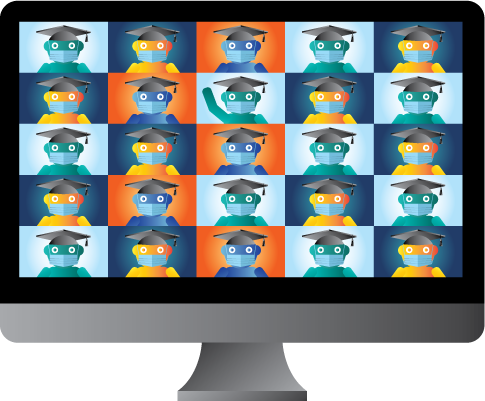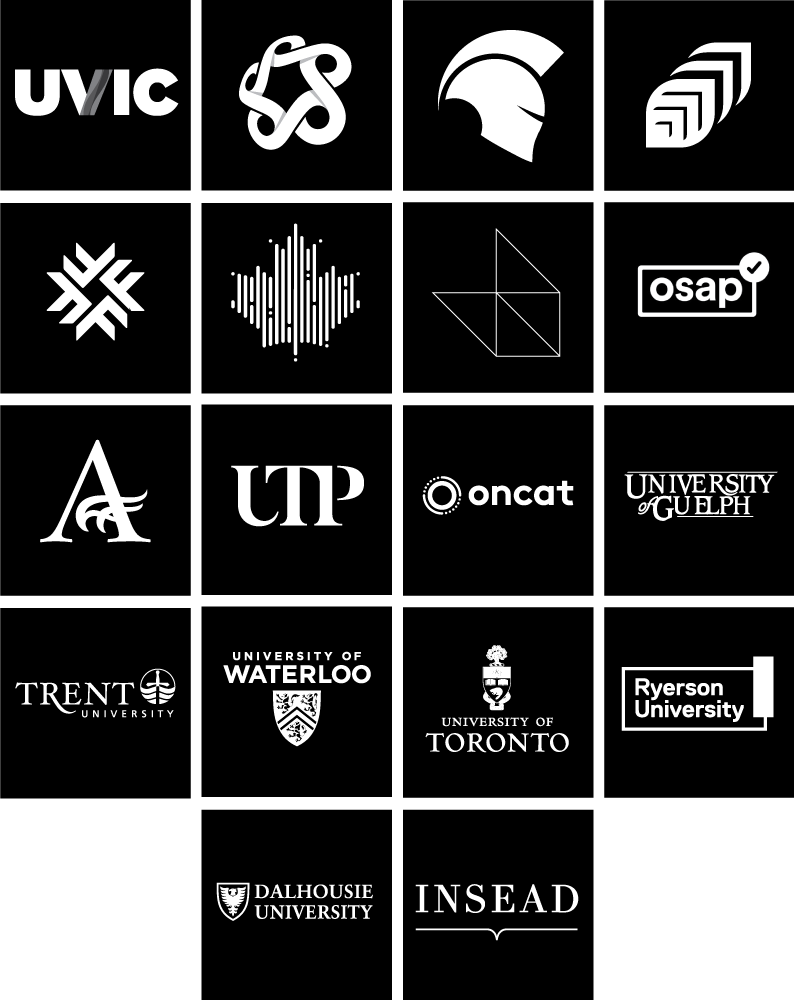Things We Think About
CHRONICLES

Learning Resilience
Post-Secondary educators across North America are bracing for a wildly unpredictable 2020-2021 academic year, buffeted by myriad learning, teaching, health and economic challenges.
Yet, while these immediate, pandemic-driven trials preoccupy most administrators’ attention, the upheavals of 2020 have also accelerated dynamic forces that will stress test the mettle and creativity of higher learning in even more surprising ways.
In VUCA times – shorthand for volatile, uncertain, complex and ambiguous – who will thrive? What does resilience and sustainability look like for institutions of higher learning? We asked several educational thought leaders to share their insights on lessons learned and the opportunities ahead.
Shift from doing to learning.
Universities and colleges may have a reputation for being change resistant but the first wave of response to the pandemic crisis was swift, with an inspiring, can-do pragmatism that impressed many, especially academics.
Some observers argue that, however unsettling, COVID demands are only short-term interruptions for academia. All of our interviewees have a very different take. They see profound disruptions and transformations ahead and the next phases of response are critical. For Glenn Craney, Vice Provost, Deputy Provost, University Planning at Ryerson University, “The biggest surprise was how quickly we’ve pivoted. We transitioned the last quarter of the [spring] semester to online in seven days. That involved 7,000 courses and 2,000 faculty. We did that! We care and we can come together to solve problems. It’s nothing short of amazing! People have gone beyond!”
Joanne Shoveller, Vice-President, Advancement at the University of Waterloo echoes Craney’s view: “The first phase of the response was incredible to watch. The short-term impact was impressive. Most organizations have been truly resilient. Everybody dug in fast, producing PPE, doing research etc. Donors and alumni were also unbelievably generous with their time and support.”
For Alastair Summerlee, Carleton’s former interim president, current disruptions have only laid bare fundamental questions for academia that can now be confronted: “l’ve always had the view that post-secondary education has hidden a tsunami of issues.” Robert Luke, newly minted CEO of eCampus Ontario, concurs that there’s no going back to pre-COVID norms saying, “There is no going back to business as usual for post-secondary education given the long road to a vaccine. This is an opportunity for PSE to modernize and realize some of the deep structural changes we need.”
Shoveller cautions that it’s important to prepare now for the next wave of disruption, whether from the pandemic or other big events. “It will happen again. We need to be able to expand and contract as an institution. Quality organizations will survive but there’s a huge reckoning coming. We must be more nimble, more cost-effective and more value-driven than ever. We see opportunity for great innovation in disruption. How can we take advantage of big ideas and the receptivity of our audiences?” Ryerson’s Craney argues that institutions of learning must be diligent about learning from this crisis. “We’re just emerging from the ‘doing’… The first response was ‘What’s going on?’ But evaluations are lagging,” he notes. “The key questions to address are ‘How’s it working? How do we create supports?’ Documentation is key. Nobody documented SARS.”
There is no going back to business as usual for post-secondary education given the long road to a vaccine. This is an opportunity for PSE to modernize and realize some of the deep structural changes we need.
~ Robert Luke, CEO of eCampus Ontario
There’s a hunger for disruption.
What’s changed is the demand. “Today, there’s receptivity to do things that are disruptive,” according to Joanne Shoveller.
To drive the point home, she cites themes from CEO Roundtables conducted last spring by the University of Waterloo. They highlighted critical themes for business like the breakdown of global linkages; addressing major shifts in the economy; reinventing business processes; and whole new models of talent development. She emphasizes that, “Business wants access to a diff erent kind of talent – resilient grads who know how to behave in this kind of environment.” Waterloo’s response includes its Future Ready Talent Framework. This research-backed tool is designed to help students, employers and educators understand key competencies needed to navigate the future of work and learning.
Glenn Craney also underscores the need to respond quickly to dramatic shifts in business needs. Ryerson is home to the Future Skills Centre which brings together experts and organizations to share research and innovative programs that can prepare Canadians for tomorrow’s economy. “Workplaces will change. We need to change with them using a research-based approach… Given labour market uncertainty, reskilling and lifelong learning will be key.” Robert Luke, who has been VP of Research and Innovation at two post-secondary schools, is equally adamant about the importance of better integration with the labour market. Education has always been articulated to labour markets, though this is somewhat dependent on program and type of organization.
The issue of relevance has even deeper roots for Alastair Summerlee, who is now leading Education City, a ground-breaking partnership between Carleton University, Algonquin College, La Cité and the University of Ottawa. The goal of the collaboration is to develop more integrated, “stackable” academic programs and shared research efforts that will help find solutions to challenges faced by businesses, non-profits and governments.
According to Summerlee, post-secondary institutions for too long have been, “self-regenerating the next generation of academics like a factory production model – the ‘widget-ization’ of education. The masses don’t want to be academics. They care about will I get a job.” He cites UN Sustainability Goals and RBC’s “Humans Wanted” study of changing business needs as touchpoints points for reimagining the role of higher education in preparing students for the future of work.
Post-secondary institutions for too long have been, “self-regenerating the next generation of academics like a factory production model – the ‘widget-ization’ of education.”
~ Alastair Summerlee, Education City
Fuel innovation with collaboration.
There’s no doubt that calamity has unleashed and accelerated a remarkable wave of transformations in higher education, particularly in online delivery.
“The pandemic has created a great playground for experimentation,” says Glenn Craney, “with great opportunities to rethink the way we’re using technology. The gold standard was where can tech can help pedagogy but the pace of change was slow. We’ve taken a huge leap forward.” But Robert Luke cautions that, “the vast majority of academics – the professoriate – have limited experience with digital learning precisely because they did not learn that way. We need to seize this opportunity to turn the page on current education practices. The pandemic has shifted online education from a ‘nice to do’ to making it a ‘need to do’ priority.”
Julia Christensen Hughes is encouraged by a new willingness to explore different approaches to teaching: “Faculty are being really creative to ensure their students are going to get an excellent online learning experience… They’re coming together in learning communities, asking questions, sharing ideas. I’ve never seen this level of discourse about teaching and technology before. I’m hoping that will stick.”
The push to new formats – stackable credits, micro-credentials, transferability – has also been accelerated by the shift to online learning. While face-to-face learning will always be important, increasingly students expect a range of options to meet their particular circumstances. “As universities are finally discovering that you can offer a quality, online degree, more and more education is going to be consumed in a different way. Universities have had this one-size-fits-all notion. Recognizing that people come with all kinds of different experiences, opportunities and obligations – flexibility and accessibility are going to be the future,” states Christensen Hughes.
The pandemic has created a great playground for experimentation.
~ Glenn Craney, Ryerson University
Robert Luke likens current academic models to the music industry of the 90s, well before the rise of Napster and iTunes. “Taking a program is like buying the LP. You had to buy the whole record back then. The current model takes agency away from learners. It could be more like Spotify and other streaming services where you can be exposed to music you might like based on what you do like.” In his view, shifting the focus from being teaching-centric to learning-centric, with full credential laddering, will significantly enhance the student experience in future.
However, the biggest transformations ahead for higher ed aren’t happening at individual institutions. The current climate has catalyzed remarkable levels of collaboration across networks of institutions driven by economics, urgency and a genuine we’re-in-this-together sentiment. “Shared platforms with other universities create neat connections in both organic and structured ways,” notes Craney. “We’re creating markets. These networks won’t go away after the crisis. What’s still lagging is the technology, infrastructure and policies to support them.” For context, he points to two examples: A consortium of Canadian institutions is now collaborating (with start-up financial support from the McConnell Foundation) on rapid curation, development and deployment of digital resource materials to support common, high-priority, first-year university courses. Internationally, the WC2 Network is an international collective of top universities located in the heart of major world cities to address culture, environment and political issues of common interest.
Education City, the Ottawa-based initiative led by Alastair Summerlee, is far more than bilingual partnership among two colleges and two universities to deliver 4-year, joint degree programs. With the city of Ottawa (home to about 100,000 post-secondary students at any given time) and major employers as key players, it’s part of an economic development strategy for the region. For students, the benefit is combining two years on campus, drawing on resources from four institutions, followed by two years of enhanced on-line learning while employed by a participating organization. Education City’s flexible, laddered approach is intended to boost employability, foster entrepreneurial activities and provide a robust platform for life-long learning, skills retraining and retooling based on societal demands.
For Summerlee, what’s been most surprising is the commitment to, “true collaboration across institutions and organizations, a never-before willingness to talk about how do we serve clients?” The pilot online program in business is being developed around small cohorts of eight people which Summerlee sees as ironic, going back to the early roots of education: “Universities like Singapore, Oxford, Cambridge and Bologna really focus on educating the person, creating a sense of belonging and responsibility with cohorts. The City has truly embraced it. There’s power in truly bilingual education for NGOs, tech companies, and government. We can create research across the City.” Working with industry advisors on new competencies for the future, he sees vital, long-term opportunities and benefits in terms of reskilling workforces as well.
Robert Luke points out that partnering closely with government and industry will be even more crucial for the education sector given the, “perfect storm of what appears to be an emergent economic nationalism and the need to ‘re-shore’ manufacturing in order to limit our dependence on global supply chains, something that impeded our ability to acquire personal protective equipment when the pandemic first struck. Close partnerships between academic institutions and industry will help in broader economic recovery and rebuild efforts by helping build more local economic resilience while giving experiential learning opportunities to students.”

Education’s Pharmakon Moment
The ancient Greek word “pharmakon” is paradoxical and can be translated as both remedy and poison.
Culture and brand drive resilience.
One of the most important attributes of resilient organizations is the ability to retain a strong sense of identity in the midst of change and upheaval.
Start with the “why,” author Simon Sinek recommends. Alastair Summerlee describes Education City’s “why” in terms of, “What is it we all know will make a difference? Those shared values are key.” Uniting diverse collaborators around a sense of purpose is essential when there are many unknowns. “The story needs to be inspiring and create a sense of possibility,” Summerlee adds. Ryerson’s Craney also reiterates the importance of values in turbulent times: “Institutions need to know themselves well. When there isn’t a lot of certainty, we fall back on our values and commitments.
Our priorities don’t change, just how we approach them in a crisis. We keep coming back to the Ryerson way. How does everyone deliver according to our version of values? Institutions that really understand what academic excellence means for them will be far better off. Students understand that too and they vote with their feet. The schools that adapt will do well. What I love about Ryerson is the ‘can do’ attitude that’s part of its DNA – that value of never give up.”
The question that academics must pay attention to now, in Joanne Shoveller’s view is, “Are we really going to change? In this next wave, can we take advantage of big ideas and respond to that receptivity to do things that are disruptive?” Robert Luke also spoke of a the need to ensure the recovery is equitable: “We’re clearly seeing how those who are marginalized are more disadvantaged from the pandemic. Huge disparities are being laid bare.” He describes it as higher education’s “pharmakon” moment. The ancient Greek word “pharmakon” is paradoxical and can be translated as both “remedy” and “poison.” It’s a powerful call to action for academia – make the pandemic “poison” the remedy!
This situation has identified the stodginess of higher education institutes… those who act with ingenuity and integrity will turn the crisis into unprecedented opportunity.”
~ 2020 Study, Imagining the future of higher ed in Canada from administrator, faculty perspectives, George Velestsianos and Jeff Seaman
FIVE SIMPLE ACTIONS
ACTION
PLANNING

MIT Technology Review reports 64% of survey respondents agree that COVID-19 has been a catalyst to innovation.
Here are five simple actions that leaders in higher education can do to build a more resilient brand and internal culture

1 / Decode your resilience
Every institution has been “stress tested” in 2020.
Now is the time to ask…
→ What have we learned?
→ What strengths can we celebrate, reinforce and amplify?
→ What gaps do we need to address?
→ What successes can we build on?
Action Plan
The Resilience Playbook is an online, AI-powered assessment tool that enables teams and organizations to measure their sense of resilience and confidence based on six capacities of adaptive, “shockproof” organizations. A quick, affordable way to take the pulse of your organization and capture culture-building insights.
2 / Fine tune your insights
How have your stakeholders’ expectations shifted in 2020? What matters now to decision-makers? Whether they’re students or alumni, donors, partners and other influencers, this is the time to get a sharper view of how others see your offerings in a competitive context.
Action Plan
Consider a mix of qualitative and quantitative research to dive below the surface of evolving audience priorities. With our expert research partners, The Strategic Counsel, we focus on creating tailored, cost-effective insight generation for higher ed decision-makers grappling with tough market research questions.
3 / Recalibrate your value proposition
The more things change, the more the basic questions still matter: Why us? Why now? Sometimes little nudges are all it takes to reaffirm or recontextualize your institution or faculty brand messaging to be even more relevant.
Action Plan
Start with the whys. Consider a “Why Here. Why Now.” workshop with your leadership team. Our facilitation techniques are designed to identify opportunities to sharpen differentiation and reaffirm your most compelling attractors for key audiences.
4 / Create a brand collaboration “platform”
Enable groups across the institution to develop faculty- and program-specific messaging that aligns effectively with your overall brand.
Action Plan
We can help make campus communications more effective with a brand-based “platform” strategy that facilitates cross-campus collaboration in creating, sharing and distributing content based on messaging frameworks, guidelines and content-sharing technologies.
5 / Design for an omnichannel world
As learning and communications become more interactive, don’t forget to update your identity elements for rich media and immersive environments.
Action Plan
How does your identity work in non-traditional media? How does it move? How does it sound? Does it play well with others. Even the most powerful identifiers and guidelines can use a little boost sometimes.
About Trajectory
Trajectory represents a special breed of “purpose-driven” firms that integrates the best of brand strategy, design thinking and stakeholder engagement strategies. We work with leading organizations to fuel their success through brand-driven strategies, compelling stories, meaningful engagement, experience design and powerful community-building tools.
Trajectory’s roster of educational institutions speaks to our depth in strategy, engagement, design and communications. We’ve had the privilege of working with leading colleges (3), universities (8), polytechnics (3), individual faculties, international business schools (INSEAD, France); and prestigious education-focused enterprises in research and publishing. Our team members also teach and lecture regularly at a number of North American schools including Georgetown University (Washington, DC) as well as Schulich School of Business, York University; OCAD University; George Brown College (Toronto, Ontario).
From campus-wide engagement and brand strategy to robust design systems and communications for recruitment, advancement and reputation-building, we understand the unique demands on post-secondary leaders for cost-effective, compelling approaches to connecting with the people and communities that matter most.

Research/Engagement
→ Stakeholder engagement
→ Qualitative research, surveys
Strategy
→ Brand strategy, positioning, promise, values
→ Brand relationships and architecture
→ Brand platform strategy (roles, policies, brand management)
→ Brand launch and activation planning
→ Communications & marketing activation strategies and roadmaps
→ Senior-level consulting
Naming, Voice
→ Naming, nomenclature, brand voice
→ Writing for brand communications
Design, Creative
→ Identity design systems and guidelines
→ Books, publications, corporate communications
→ Creative concepts for print & digital marketing
→ Concept, writing & design for branded content: print, video, interactive media, exhibits, presentations
Facilitation
→ Liberating Structures
→ Appreciative Inquiry
→ VUCACanvas, Resilience Playbook
Key partnerships
→ Research (The Strategic Counsel)
→ Digital design: web & social (Stack Creative)
→ Video/interactive (Q Media)
→ HowSpace engagement/training platform
